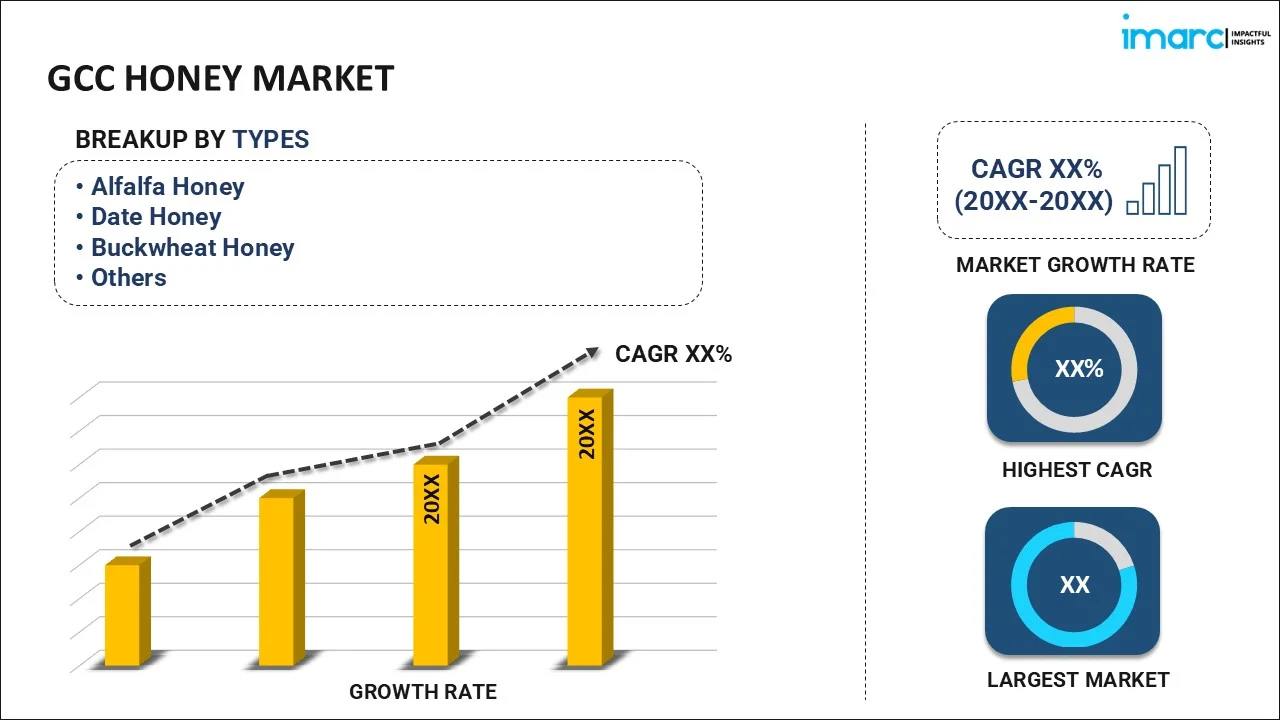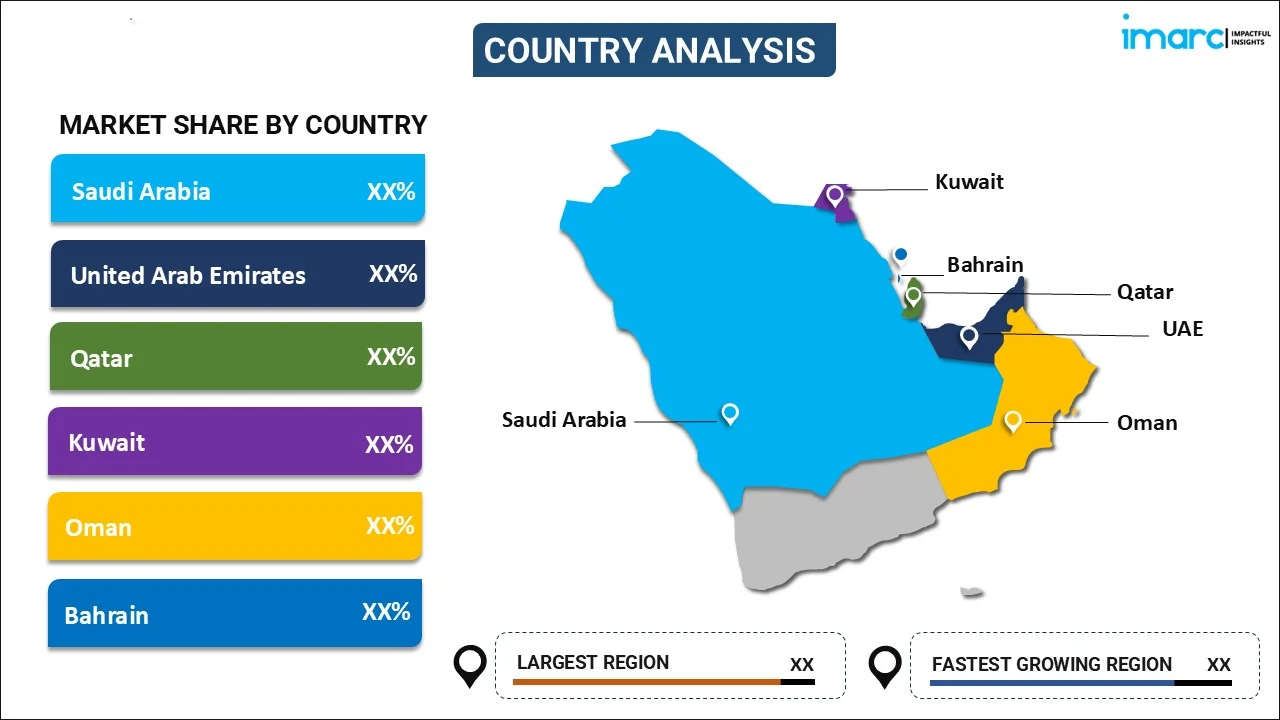
GCC Honey Market Report by Type (Alfalfa Honey, Date Honey, Buckwheat Honey, Acacia Honey, Clover Honey, Linden Honey, and Others), Application (Food and Beverages, Personal Care and Cosmetics, Pharmaceutical, and Others), Distribution Channel (Supermarkets and Hypermarkets, Convenience Stores, Online Stores, and Others), and Country 2024-2032
Market Overview:
The GCC honey market size is projected to exhibit a growth rate (CAGR) of 6% during 2024-2032. The increasing urbanization and income levels, expanding retail sectors, rapid growth in the tourism and hospitality sectors, increasing beekeeping initiatives, augmenting demand for natural and organic products, increasing product adoption due to cultural and traditional use, and rising government support represent some of the key factors driving the market.
|
Report Attribute
|
Key Statistics
|
|---|---|
|
Base Year
|
2023
|
|
Forecast Years
|
2024-2032
|
|
Historical Years
|
2018-2023
|
| Market Growth Rate 2024-2032 | 6% |
Honey is a natural and delightful substance produced by honeybees (Apis mellifera) through a fascinating process of collecting nectar from flowers. This golden, viscous liquid has been cherished by humans for thousands of years for its rich sweetness and numerous health benefits. The bees consume the nectar, and through enzymatic reactions within their bodies, they transform it into honey, which is then stored in hexagonal wax cells within their hives. The flavor, aroma, and color of honey can vary significantly depending on the types of flowers the bees visited during the nectar collection process. Common varieties include clover, acacia, lavender, and wildflower honey, each offering a unique taste profile. Aside from being a delectable natural sweetener, honey boasts various health properties. It contains antioxidants, enzymes, vitamins, and minerals that can promote digestive health, soothe sore throats, and even aid in wound healing when used topically due to its antimicrobial properties. Additionally, the low water content and high acidity of honey create an inhospitable environment for bacteria, making it an excellent preservative.
GCC Honey Market Trends:
The growing awareness about the health benefits of natural products has led to a surge in demand for honey as a healthier alternative to refined sugar. Honey is considered a natural sweetener and is perceived to have various medicinal properties, including its ability to boost the immune system and provide antioxidant benefits. Additionally, the growth of the retail industry, including supermarkets, hypermarkets, and e-commerce platforms, has made honey more accessible to consumers. This has significantly boosted the distribution and availability of honey products across the GCC region. Other than this, the GCC region attracts a large number of international tourists, especially during the winter season. As honey is a popular souvenir and gift item, the tourism sector has become a key driver of honey sales, creating a demand surge during peak tourist seasons. Besides this, GCC countries have initiated programs to encourage local beekeeping and honey production. These initiatives aim to reduce dependence on honey imports and promote domestic honey production, leading to a positive impact on the local honey market. In line with this, with the rising global trend toward natural and organic products, consumers in the GCC region are seeking honey that is free from pesticides and additives. This has led to a higher demand for organic and pure honey products. Furthermore, honey has significant cultural and traditional importance in the GCC countries, being used in various culinary and religious practices. Its cultural significance has driven its consumption as a sweetener and medicinal product for generations. Moreover, governments in the GCC region are actively supporting the development of the honey industry through incentives, subsidies, and awareness campaigns, further boosting the growth of the market.
GCC Honey Market Segmentation:
IMARC Group provides an analysis of the key trends in each segment of the GCC honey market report, along with forecasts at the regional and country levels for 2024-2032. Our report has categorized the market based on type, application, and distribution channel.
Type Insights:

- Alfalfa Honey
- Date Honey
- Buckwheat Honey
- Acacia Honey
- Clover Honey
- Linden Honey
- Others
The report has provided a detailed breakup and analysis of the market based on the type. This includes alfalfa honey, date honey, buckwheat honey, acacia honey, clover honey, linden honey, and others.
Application Insights:
- Food and Beverages
- Personal Care and Cosmetics
- Pharmaceutical
- Others
A detailed breakup and analysis of the market based on the application has also been provided in the report. This includes food and beverages, personal care and cosmetics, pharmaceutical, and others.
Distribution Channel Insights:
- Supermarkets and Hypermarkets
- Convenience Stores
- Online Stores
- Others
The report has provided a detailed breakup and analysis of the market based on the distribution channel. This includes supermarkets and hypermarkets, convenience stores, online stores, and others.
Country Insights:

- Saudi Arabia
- UAE
- Qatar
- Oman
- Kuwait
- Bahrain
The report has also provided a comprehensive analysis of all the major regional markets, which include Saudi Arabia, the UAE, and Qatar, Oman, Kuwait, and Bahrain.
Competitive Landscape:
The report has also provided a comprehensive analysis of the competitive landscape in the GCC honey market. Competitive analysis such as market structure, key player positioning, top winning strategies, competitive dashboard, and company evaluation quadrant has been covered in the report. Also, detailed profiles of all major companies have been provided.
GCC Honey Market Report Coverage:
| Report Features | Details |
|---|---|
| Base Year of the Analysis | 2023 |
| Historical Period | 2018-2023 |
| Forecast Period | 2024-2032 |
| Units | US$ Million |
| Scope of the Report | Exploration of Historical and Forecast Trends, Industry Catalysts and Challenges, Segment-Wise Historical and Predictive Market Assessment:
|
| Types Covered | Alfalfa Honey, Date Honey, Buckwheat Honey, Acacia Honey, Clover Honey. Linden Honey, Others |
| Applications Covered | Food and Beverages, Personal Care and Cosmetics, Pharmaceutical, Others |
| Distribution Channels Covered | Supermarkets and Hypermarkets, Convenience Stores, Online Stores, Others |
| Countries Covered | Saudi Arabia, UAE, Qatar, Bahrain, Kuwait, Oman |
| Customization Scope | 10% Free Customization |
| Report Price and Purchase Option | Single User License: US$ 3699 Five User License: US$ 4699 Corporate License: US$ 5699 |
| Post-Sale Analyst Support | 10-12 Weeks |
| Delivery Format | PDF and Excel through Email (We can also provide the editable version of the report in PPT/Word format on special request) |
Key Questions Answered in This Report:
- How has the GCC honey market performed so far and how will it perform in the coming years?
- What has been the impact of COVID-19 on the GCC honey market?
- What is the breakup of the GCC honey market on the basis of type?
- What is the breakup of the GCC honey market on the basis of application?
- What is the breakup of the GCC honey market on the basis of distribution channel?
- What are the various stages in the value chain of the GCC honey market?
- What are the key driving factors and challenges in the GCC honey market?
- What is the structure of the GCC honey market and who are the key players?
- What is the degree of competition in the GCC honey market?
Key Benefits for Stakeholders:
- IMARC’s report offers a comprehensive quantitative analysis of various market segments, historical and current market trends, market forecasts, and dynamics of the GCC honey market from 2018-2032.
- The research study provides the latest information on the market drivers, challenges, and opportunities in the GCC honey market.
- Porter's five forces analysis assist stakeholders in assessing the impact of new entrants, competitive rivalry, supplier power, buyer power, and the threat of substitution. It helps stakeholders to analyze the level of competition within the GCC honey industry and its attractiveness.
- Competitive landscape allows stakeholders to understand their competitive environment and provides an insight into the current positions of key players in the market.
Need more help?
- Speak to our experienced analysts for insights on the current market scenarios.
- Include additional segments and countries to customize the report as per your requirement.
- Gain an unparalleled competitive advantage in your domain by understanding how to utilize the report and positively impacting your operations and revenue.
- For further assistance, please connect with our analysts.
 Inquire Before Buying
Inquire Before Buying
 Speak to an Analyst
Speak to an Analyst
 Request Brochure
Request Brochure
 Request Customization
Request Customization




.webp)




.webp)












